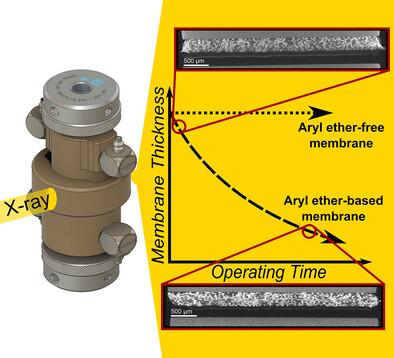利用Operando x射线微断层扫描研究阴离子交换膜电解的反卷积降解机制
IF 26
1区 材料科学
Q1 CHEMISTRY, PHYSICAL
引用次数: 0
摘要
阴离子交换膜水电解器由于膜层和催化剂层中的离子单体耐久性低而受到阻碍。研究这些系统中的离子单体降解是具有挑战性的,因为其主要机制——导致催化剂分离、膜变薄和阳离子功能丧失——对细胞电位有相反的影响。因此,电化学测量本身不足以阐明降解的根本原因。为了解决这个问题,开发了一种定制的微型电解电池,用于1.6 μ m分辨率的膜电极组件的x射线微断层扫描成像。这种设置可以在静态和操作条件下研究电解槽的整个活性体积,并对标准5平方厘米的实验室细胞进行验证。一项对fumasep基催化剂涂覆膜降解的operando研究表明,在稳定性测试中,膜明显变薄,膜离子电导率下降,导致欧姆电阻和细胞电位增加。相比之下,Selemion膜的厚度和导电性变化很小,当暴露在同步辐射下时,与Fumasep相比,Selemion膜的稳定性明显更高。该平台与电化学材料和器件的operando研究相关,包括质子交换膜电解槽、燃料电池和使用实验室和同步加速器x射线源的CO2电解槽。本文章由计算机程序翻译,如有差异,请以英文原文为准。

Deconvoluting Degradation Mechanisms in Anion Exchange Membrane Water Electrolysis Using Operando X-ray Microtomography
Anion exchange membrane water electrolysers are held back by the low durability of the ionomer in the membrane and catalyst layers. Studying ionomer degradation in these systems is challenging because the main mechanisms - which result in catalyst detachment, membrane thinning, and loss of cationic functionality - have opposing effects on the cell potential. Electrochemical measurements alone are therefore insufficient for elucidating the underlying causes of degradation. To address this, a bespoke miniature-electrolyser-cell is developed for X-ray microtomography imaging of membrane electrode assemblies at 1.6 µm resolution. This setup enables the study of the entire active volume of the electrolyser under static and operando conditions and is validated against standard 5 cm2 laboratory cells. An operando investigation of degradation in Fumasep-based catalyst-coated membranes reveals both significant membrane thinning and loss of membrane ionic conductivity during stability testing, leading to increased ohmic resistance and cell potential. In contrast, a Selemion membrane shows minimal changes in thickness and conductivity and is significantly more stable compared to Fumasep when exposed to synchrotron radiation. This platform has relevance for operando studies of electrochemical materials and devices generally, including proton exchange membrane electrolysers, fuel cells, and CO2 electrolysers using both lab-based and synchrotron X-ray sources.
求助全文
通过发布文献求助,成功后即可免费获取论文全文。
去求助
来源期刊

Advanced Energy Materials
CHEMISTRY, PHYSICAL-ENERGY & FUELS
CiteScore
41.90
自引率
4.00%
发文量
889
审稿时长
1.4 months
期刊介绍:
Established in 2011, Advanced Energy Materials is an international, interdisciplinary, English-language journal that focuses on materials used in energy harvesting, conversion, and storage. It is regarded as a top-quality journal alongside Advanced Materials, Advanced Functional Materials, and Small.
With a 2022 Impact Factor of 27.8, Advanced Energy Materials is considered a prime source for the best energy-related research. The journal covers a wide range of topics in energy-related research, including organic and inorganic photovoltaics, batteries and supercapacitors, fuel cells, hydrogen generation and storage, thermoelectrics, water splitting and photocatalysis, solar fuels and thermosolar power, magnetocalorics, and piezoelectronics.
The readership of Advanced Energy Materials includes materials scientists, chemists, physicists, and engineers in both academia and industry. The journal is indexed in various databases and collections, such as Advanced Technologies & Aerospace Database, FIZ Karlsruhe, INSPEC (IET), Science Citation Index Expanded, Technology Collection, and Web of Science, among others.
 求助内容:
求助内容: 应助结果提醒方式:
应助结果提醒方式:


